Cultural Programme
As part of the Symposium Social and Cultural Programme, the following activities will be offered to all participants:
- St.-Petersburg City Tour (covered by registration fee)
- Tour of the Hermitage Museum (covered by registration fee)
- Guided tours through the National Library of Russia (compliments of NLR)
- Theatres (at participants' expense)
- Tour to Tsarskoye Selo (30 Euros)
St.-Petersburg City Tour (October 25, Saturday)
Duration - 3 hours / bus transfer
BUS DEPARTURE PLACE: Nevsky Prospect at the "Gostinny Dvor" Metro station.
SIGHTS TO BE SEEN: Nevsky Prospect and Gostinny Dvor (Merchant's Inn), Sadovaya Ulitsa (Garden st.); Gorokhovaya Ulitsa.; Malaya Morskaya Ulitsa(Small Sea st.); St. Isaac's Cathedral (a 5 minute stop), the monument to Nicolas I; the Horse Guards' Riding-Hall; the Bronze Horseman; the State Admiralty; the Winter Palace; Koniushennaia sq. (Stable sq.); the Church of the Holy Savior on Spilled Blood (a 5 minute stop), the Mars' Field; Michael's Castle; the Summer Garden; the monument to A.V. Souvorov; the Troitsky Most (the Trinity bridge); the Log Cabin of Peter I; the cruiser Aurora (a 5-10 minute stop), the palace of Matilda Kshesinskaya; Troitskaya Ploshchad. (Trinity sq.); Peter and Paul's Fortress (a 5 minute stop), the Spit of Vasilyevsky Island; the Guest Yards of D. Trezzini and Quarenghi; the St. Petersburg University (formerly - the building of Twelve Collegia; Kunstkamera (the Chamber of Curiosities) (a 5 minute stop), Water tour of the Embankment )and Dvortsovy Most (Palace bridge) (optional if weather permits); Dvortsovaya Ploshchad. (Palace sq.) (a 5 minute stop).
NEVSKY PROSPECT: the House of Wawelberg; the house of the Chief of Police, N.I. Chicherin; Wolf and Berange's Confectionery; Stroganovs' Palace; the house of the former Dutch Church; the German Lutheran Church; the Kazan Cathedral; the Singer Company building; the Small Hall of the Philharmonic Society; the Roman Catholic Church of St. Catherine, Gostinny Dvor (Merchant's Inn) (a 10 minute stop).
Tour of the Hermitage Museum
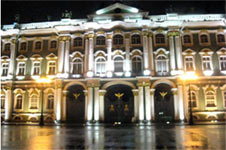 The State Hermitage occupies six magnificent buildings situated along the embankment of the River Neva, right in the heart of St Petersburg. The leading role in this unique architectural ensemble is played by the Winter Palace, the residence of the Russian tsars that was built to the design of Francesco Bartolomeo Rastrelli in 1754-62. This ensemble, formed in the 18th and 19th centuries, is extended by the eastern wing of the General Staff building, the Menshikov Palace and the recently constructed Repository.
Put together throughout two centuries and a half, the Hermitage collections of works of art (over 3,000,000 items) present the development of the world culture and art from the Stone Age to the 20th century. Today the Museum is creating its digital self-portrait to be displayed around the world. Computer technologies enable the State Hermitage Museum to provide people from all over the world with wider access to information about the Museum and its treasures.
The State Hermitage occupies six magnificent buildings situated along the embankment of the River Neva, right in the heart of St Petersburg. The leading role in this unique architectural ensemble is played by the Winter Palace, the residence of the Russian tsars that was built to the design of Francesco Bartolomeo Rastrelli in 1754-62. This ensemble, formed in the 18th and 19th centuries, is extended by the eastern wing of the General Staff building, the Menshikov Palace and the recently constructed Repository.
Put together throughout two centuries and a half, the Hermitage collections of works of art (over 3,000,000 items) present the development of the world culture and art from the Stone Age to the 20th century. Today the Museum is creating its digital self-portrait to be displayed around the world. Computer technologies enable the State Hermitage Museum to provide people from all over the world with wider access to information about the Museum and its treasures.
The basic display areas of the State Hermitage occupy 365 rooms in the Main Museum Complex located in the historic centre of St Petersburg. This consists of six buildings constructed in the 18th and 19th centuries, among which the most important is the Winter Palace, the former imperial residence. The Winter Palace, the Small Hermitage, the Old Hermitage and the New Hermitage display the collections of monuments of culture and art of the ancient world, Western Europe, Russia and the countries of the Orient, as well as archeological and numismatic collections. The Hermitage Theatre and the Reserve House also form part of the Main Museum Complex.
Guided tours through the National Library of Russia (October 22- 24)
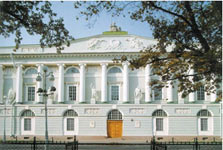
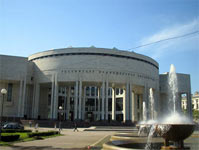
The NLR Main building, October 22, 15:00, Sadovaya Ulitsa, 18 at the corner of Nevsky prospect).
The tour will include:
Cartographic Department, the richest collection of cartographic materials,
Rare Books Department, including the "Faust's Study", which reconstructs an atmosphere of a West European monastic library of the 15th century,
Manuscripts Department, one of the world's largest repositories of manuscripts of different epochs and cultural traditions,
Center for the Study of the Age of Enlightenment, which includes the Voltaire private library.
The NLR New building, October 23-24, Moskovsky prospect, 165/2.
Guided tours through the New building of the National Library of Russia will be given before and after sessions on October 23 and 24.
Theatres
Participants are welcome to check programs of the theatres and concert halls, and either book tickets online, or ask the Symposium Registration Group for assistance. Some of the theatres and concert halls are listed below:
Mariinsky Theatre
Address: 1, Teatralnaya Square, St Petersburg,
http://www.mariinsky.ru/en/playbill?pbmy=200802
Mikhailovsky Theatre
Address: Iskusstv pl., 1 St. Petersburg,
http://mussorgsky.narod.ru/temple_1/homepage_ru.htm
St. Petersburg Philharmonia
Address: Mikhailovskaya str., 2
http://www.philharmonia.spb.ru/eng/inform.html
Tour to Tsarskoye Selo (October 25, Saturday)
The duration of the tour is about 6 hours. The extra fee of 30 Euros will charged for those who sign up to take this tour.
Departure from the hotels will be by bus. A short historical excursion will be offered during the bus route. In Tsarskoe Selo (or Tsar's Village in English), there will be a tour of the Catherine Palace, including an excursion to the Amber Room, and of the Catherine Park.
The bus will take the guests back to the hotels.
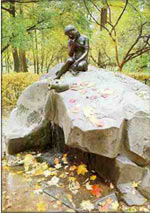
Located just 25 kilometers south of the city, the estate boasts a large landscaped park, dotted with architectural decorations, and centered on the magnificent blue, white and gold Catherine Palace.
Named after its creator, Empress Catherine, the second wife of Peter the Great, the original palace was built between 1717 and 1723 by the architect Braunstein. The palace was expanded later in the century and given a new, richly decorated Baroque facade by the architect Francesco Bartholomeo Rastrelli.
For more information please visit the Tsarskoe Selo website:
http://www.alexanderpalace.org/tsarskoe/
The Catherine Palace houses some beautiful Baroque interiors, including the luxurious Grand Hall, a long, gold, mirrored ballroom. The Palace also boasts a unique Amber Room, whose priceless amber panels were stolen by Nazi troops during WWII, but which have now been painstakingly recreated by Russian craftsmen.
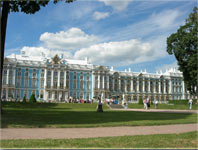 |
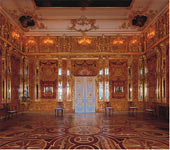 |
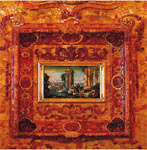 |
Catherine's Palace |
Amber Room |
Amber Room |
Empress Elizabeth, the daughter of Peter the Great, preferred Tsarskoye Selo to many of the other Imperial residences around St. Petersburg, as did the famous Catherine the Great herself. Catherine particularly enjoyed the Neo-Classical Cameron Gallery section of the palace, built by the Scottish architect Charles Cameron between 1781 and 1786. Adjacent to the gallery and also worthy of note is Cameron's Cold Baths building, an extravagant bathhouse of semi-precious stones.
Forming the core of the estate, Tsarskoye Selo boasts almost 600 hectares of beautiful parkland.
In front of the Catherine Palace visitors can enjoy formal gardens with finely trimmed trees and bushes, geometrically designed flowerbeds and fine marble statues. This section of the park is also home to various beautiful structures, including the Grotto, the Upper and Lower Baths and Rastrelli's delightful blue and white Hermitage building. Beyond the Cameron Gallery and to the south of the Catherine Palace lies the wilder, more natural section of the estate's park.
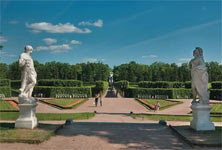 |
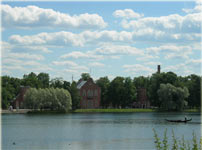 |
Focused on a large lake, where visitors can hire boats in the summer, the park is filled with meandering streams, bridges and monuments. These include the Admiralty, the Chesma Column, the Marble Bridge, modeled on one in Wilton, England, and the Pyramid, where Catherine the Great liked to bury her favorite dogs. One of the park's most elegant sculptures ("Girl with a Broken Jug") stands by the lakeside and depicts a young lady sitting near a
One of the best-hidden secrets of the Tsarskoe Selo estate is the Alexander Palace, built between 1792 and 1796 by the architect Giacomo Quarenghi.
By the turn of the 20th century the Alexander Palace had become the favorite residence of the last Russian Tsar, Nicholas II, and his family. It was from here that Nicholas's family was taken to Siberia to be executed in Ekaterinburg in 1918. Unfortunately, very few of the palace's interiors survived the ravages of this century, and after a long and painstaking restoration program, just one wing of the palace is now open to the public.
Another of Tsarskoe Selo's major attractions is the Lyceum, located on the edge of the estate. Founded at the beginning of the 19th century and remarkably well-preserved, the Lyceum was a boarding school that once taught the most celebrated of all Russian poets, Alexander Pushkin. The Lyceum was created specifically to educate members of the Russian ruling elite and prepare them for careers in government service. Visitors to the Lyceum are allowed access to its well-preserved classrooms, library, student bedrooms and much more.

